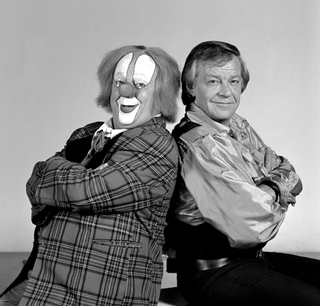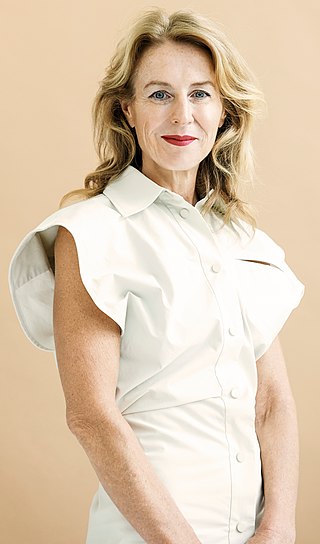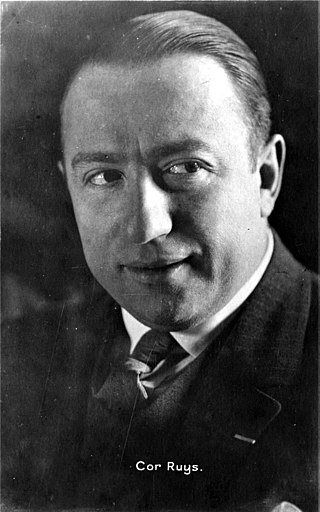
Mary Dresselhuys was primarily a Dutch stage actress, although she also appeared in a number of films. She was born in Tiel, the Netherlands, and died in Amsterdam.

Bassie & Adriaan was a television program series focusing on the adventures and lives of a circus duo consisting of clown Bassie and acrobat Adriaan, played by real-life circus duo Bas and Aad van Toor.

Halina Reijn is a Dutch actress, writer and film director.
The Anne Vondeling prize, named after the politician Anne Vondeling a member of the Dutch Labour Party, is an annual award in The Netherlands given to journalists who write in a clear manner concerning political subjects.

Heleen Mees is a Dutch opinion writer, economist, and lawyer. Involved with politics and public policy in the Netherlands and the US, she has also taught at universities in both countries.

Vrienden van het Platteland was a Dutch UCI women's road cycling team that existed in the 2000–2008 road cycling seasons.

Pieter Abramsen was a Dutch sculptor, and visiting professor at the Delft University of Technology, known for his work in which abstraction and realism are joined.

Dora Dolz de Herman was a Spanish-Dutch artist, best known for her outdoor ceramic works in the form of chairs and sofas.
Daniël (Daan) van Golden was a Dutch artist, who has been active as a painter, photographer, collagist, installation artist, wall painter and graphic artist. He is known for his meticulous paintings of motives and details of everyday life and every day images.

In Real Life, released in the Netherlands as Het echte leven, is a 2008 Dutch drama film that was written and directed by Robert Jan Westdijk. The film had its premiere at the Netherlands Film Festival on 25 September 2008 and was released on DVD the following year. The film stars Ramsey Nasr as a film director who decides to test his girlfriend's love for him. The movie's soundtrack was composed by Michel Banabila and Eric Vloeimans, and features songs from their album VoizNoiz 3 – Urban Jazz Scapes.

Loes Haverkort is a Dutch actress. She has performed in movies, television shows and theatre productions.
Wilhelmus "Willem" Tholen was a Dutch male weightlifter, who competed in the Light-Heavyweight category and represented the Netherlands at the Olympic Games.

Silvana Hildegard "Sylvana" Simons is a Surinamese-born Dutch politician and former television presenter. She has served as a member of the House of Representatives since 2021 on behalf of BIJ1, an egalitarian anti-racist party founded by Simons in 2016.

The Dutch Athlete of the Year is an annual award given to the most distinguished competitor in the sport of athletics from the Netherlands by the Royal Dutch Athletics Federation (KNAU). A shortlist is drawn up by a group of federation officials and sports journalists and then goes to a vote to the public. The award is presented at the annual end-of-year gala of the federation.

Redbad is a 2018 Dutch drama film directed by Roel Reiné. It is based on the life of Radbod, an early medieval Frisian leader. The film was intended as the middle part of a trilogy about iconic Dutch/Frisian heroes, starting with the film Michiel de Ruyter, about the 17th century admiral Michiel de Ruyter and ending with an unmade film about William of Orange.

A process of cabinet formation took place following the 2021 Dutch general election, leading to the formation of the Fourth Rutte cabinet in 2022. The coalition consisted of People's Party for Freedom and Democracy (VVD), Democrats 66 (D66), Christian Democratic Appeal (CDA) and Christian Union (CU), the same parties that formed the preceding Third Rutte cabinet. At 299 days, it was the longest formation in Dutch history.

Janine Wegman was a Dutch Hammond-organist and artist based in Rotterdam. She was one of the first Dutch people to be openly transsexual.

Cor Ruys was a Dutch actor, stage director and comedian. He is best known for playing the character of 'Potasch' in Potash and Perlmutter by Montague Glass several times and his lead performance in Henry Koster’s 1935 film The Cross-Patch.
Moray was the name of a proposed new class of submarines developed by the Rotterdamsche Droogdok Maatschappij (RDM). While a Moray class submarine was never actually built, the detailed design of the submarine class was fully completed.

Droogdok Maatschappij Soerabaja (DMS) was a Dutch shipbuilding and repair company which had a shipyard in the Dutch East Indies.


















